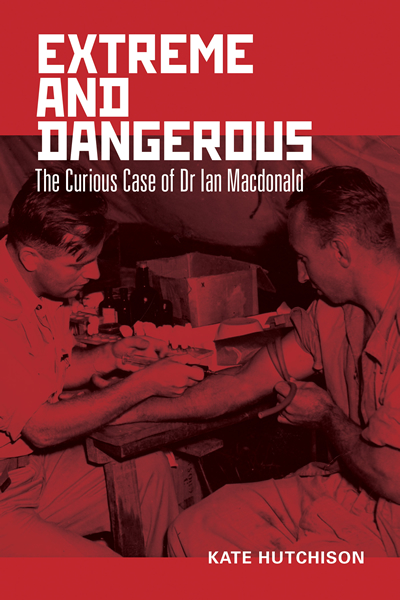
Extreme and Dangerous: The Curious Case of Dr Ian Macdonald. By Kate Hutchison. Australian Scholarly Publishing, Melbourne, 2020.
Reviewed by Mark Edmonds
The first thing to note about this book is that it is not an academic work. The language is colloquial, and the writing lends itself more to a “whodunnit” than to a socio-political or biographical work. The author is a speech pathologist and the subject matter is the life of her parents over a fifteen year period from the 1930s to the late 40s.
For all that, or perhaps because of it, this is one of the most interesting insights into the Australian intelligence community prior to WW2, and the role of communism in the early stage of the war, that the reviewer has read. The book essentially covers the professional lives of a Melbourne doctor, Ian Macdonald, and his wife. Both are professed, public communists, with Dr Macdonald being an active writer and advocate for communist ideology, at a time when the party platform included free education and universal healthcare – policies which are, by today’s standards, largely mainstream. Dr Macdonald was a Commonwealth employee with the Department of Health and for a short period was appointed to a public health role in Darwin, on the eve of the Pacific war. He spent over a year in Darwin before essentially being dismissed because of his Communist party affiliation – there being no evidence of malfeasance or attempts to subvert the war effort. Indeed, Dr Macdonald subsequently enlisted in the Army and served with distinction in Papua New Guinea, where he pioneered malaria management activities and treatments, for which he was Mentioned in Despatches.
Whilst the author takes a non-traditional approach to investigating the life of her father; specifically, how he came to be targeted by various elements of the intelligence community, her research is impeccable. Drawing on primary materials including her father’s ASIO files, War Diaries, Cabinet records, Australian Archives records, media and of course, the testimony of friends and family, she uncovers a wealth of material about the difficult relationship that Australian government authorities had with Communists. Ms Hutchinson has been able to navigate the potentially tricky problem of writing objectively about family members by contextualising Dr Macdonald’s life and work quite successfully. Her research reveals extensive informal networks between Australian Army Intelligence personnel, the Investigation Branch (ASIO’s predecessor organisation), the Victorian Police Special Branch, various military commands, the Department of Health and even the role of some of Australia’s “Secret Armies”. In particular, the author seeks to establish how it was that a public Communist, with no evidence of subversive activities and undertaking public health duties in Darwin, should be the subject of such a vigorous campaign by Melbourne based intelligence officials, to the point at which his case was deliberated over by Federal Cabinet.
Notwithstanding that the book is aimed at answering this question, as much for personal reasons as any, it covers intriguing topics like: the activities undertaken by Australian Army intelligence personnel in conducting surveillance on Australian citizens (including pre-war operations); how the Navy viewed the role of Communists in potentially disrupting the war effort on the docks in Darwin (ironically given that industrial impacts were more often realised as a result of improved technology and productivity than political agitation); what life was like for a Communist in Australia prior to the war, and the beliefs, policies and values that these people advocated; and the extent, often unreasonably, that officials went to in order to ‘prosecute’ Communists.
Hutchison’s book is an easy and really entertaining read of about 180 pages, properly footnoted and well-researched. For those unfamiliar with the socio-political history of the period and keen to learn a bit more about wartime domestic security matters and Communism, this is an excellent introduction.



